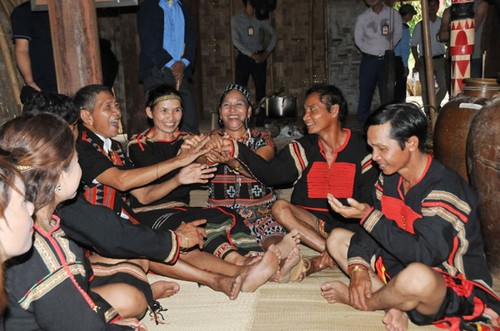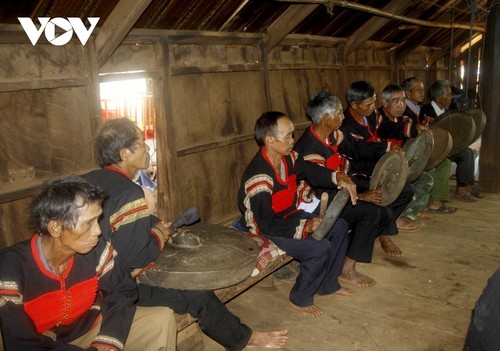 A brotherhood ceremony of the Ede in the Central Highlands province of Dak Lak. (Photo: The Duong) A brotherhood ceremony of the Ede in the Central Highlands province of Dak Lak. (Photo: The Duong) |
"I’m thankful for my friendship with Y Dao for 3 years. We thank our parents for witnessing our brotherhood ceremony. From now on, we are responsible for the other’s family and wish our parents good health and happiness," said Y Nhim at a twinning ceremony.
Y Nhim and Y Dao of Ea Tar commune, Dak Lak province, met each other three years ago. As friends they felt compatible and wanted to be brothers. So they are holding a brotherhood ceremony with the participation of a shaman, their families, and all the villagers.
“I discussed the intention with my parents and they agreed. I informed my relatives and neighbors of the ceremony. My father is very happy to have one more son. When my father gets older, he’ll have many children to take care of him,” said Y Nhim.
Senior villager Y Thon Niem who attended the ceremony, said, “The twinning ceremony is a very important Ede ritual. From now on the two will be brothers forever.”
 The gongs are played to start the brotherhood ceremony. (Photo: VOV) The gongs are played to start the brotherhood ceremony. (Photo: VOV) |
According to Ede tradition, the brotherhood ceremony is completely voluntary. It can be a twinning between two people or between two villages. After the twinning ceremony, the relationship will be closer and the pair will always help each other in life. Their friends, children, and relatives will treat each other as people of one family.
The twinning ceremony is usually held at the home of one of the two people. The host prepares 10 jars of liquor, a pig, two chickens, some sticky rice, and spices. Bronze bracelets are an indispensable part of the ceremony, because they are associated with the human life cycle.
“The bronze bracelets symbolize family bonding. They must be carefully guarded. If one is lost, the person will have bad luck or become ill. The bracelets connect the hearts of the twinning people. If a person is away from home and sees that his bracelet is still bright and clean, it means everyone in the family is still healthy. If a bracelet becomes stained, it means someone in the family is not healthy or something bad has happened," I’ruk A yun of Ea Tar commune explained.
When everyone has arrived, gongs are played to start the ceremony. Women sit on the south side of the house, while men sit on the north side. The twinning persons sit next to the tray of offerings. The shaman performs the ceremony in a solemn atmosphere.
After the ritual, a bronze bracelet is given to each twinned person. Then everyone eats and drinks to celebrate the twinning relationship. An important taboo is that the two persons must never quarrel or cause trouble. If either breaks the taboo, he is fined two or three pigs or a buffalo or a cow.
“I’m proud of our tradition. I hope our children will forever preserve the Ede culture,” said H’Duon Nie, an Ede woman.
Twinning relationships have strengthened community bond and helped the Ede overcome hardships to build a happy, prosperous life.